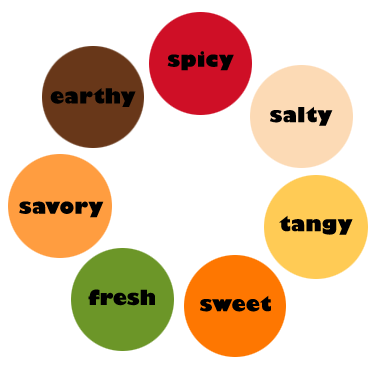Sensation and Perception of Flavor
FLAVOR
Flavor = Gustation + Olfaction
Physiology
Individual Differences
The taste of food consumes our world not because it is necessary for survivor, but because it brings pleasure.A food critic from New York Times and editor of Gourmet magazine, Ruth Reichl, describes a food flavor experience by saying:
"It is a surprise to dip your spoon into this mild-mannered soup and experience an explosion of flavor. Mushroom is at the base of the taste sensation, but it is haunted by citric tones - lemongrass, lime perhaps - and high at the top, a resonant note of sweetness. What is it? No single flavor ever dominates a dish. At first you find yourself searching for flavors in this complex tapestry, fascinated by the way they are woven together. In the end, you just give in and allow yourself to be seduced. Each meal is a roller coaster of sensations."
Notice that Reichl comments on the flavor not the taste. What most people refer to as "taste" is actually a combination of stimulation from the receptors on the tongue (taste) and stimulation of the receptors in the olfactory mucosa (smell). This taste and smell combination plus other sensations, like the burning sensation from hot peppers, is called flavor (Goldstein 2010).
The overall impression people experience from a nasal and oral stimulation combination is flavor, as mentioned previously. Read the demonstration below (Click on Try It Out!). If you attempt this demo, you may notice the difference in dificulty in tasting substances when you have your nose pinched compared to when you have your nostrils open. If your nostrils are open, then you will have an easier time experiencing flavor. This occurrence may be due to odor stimuli from food that reaches the olfactory mucosa by following along the retronasal route. The retronasal route starts at the mouth and flows through the nasal pharynx (passageway connecting the oral and nasal cavities). Pinching your nose shut prevents odors from reaching the olfactory receptros by removing the circulation of air through this channel. The importance of olfaction in the sensation of flavor has been demonstrated by experiments with chemical solutions and normal foods. Identifying solutions is more difficult when your nose is pinched shut and are commonly referred to as tasteless. Some experiments do indicate that sensations we call taste and assumed to be caused only by tongue receptors, are largely influenced by olfactory receptor stimulations. This misconception is in part due to physical stimuli entering the mouth and partially due to the tactile sensations associated with chewing and swallowing experiences.
The cortial area that responds to food is focused on the orbitofrontal cortex (OFC), because the responses from taste and smell are combined here first. The primary cortical areas for taste and olfaction, the primary somatosensory cortex, and the inferotemporal cortex in the visual "what" pathway send inputs to the orbitofrontal cortex. Because these neurons from different senses converge, the OFC has many bimodal neurons. Bimodal neurons respond to more than one sense and often respond to similar qualities. For example, a cell that responds to the taste of sweet fruits also reponds to the smell of those fruits. This shows that qualities that occur together in an environment elicit responses from neurons that are tuned to those qualities. All of these properties suggest that the OFC is a cortical center for the perceptual representation of food as well as for detecting flavor.
*FYI* The firing of neurons in the OFC reflects how much an animal will consume a particular food, which is unlike the primary taste area neurons that are not affected by hunger.
Of course we must mention the genetic differences that impact people's ability to sense certain substances' taste. One of the best demonstrations of this is that of the ability to taste a bitter substance called phenylthiocarbamide (PTC).
Arthur L. Fox, a chemist from E. I. DuPont deNemours Company in Wilmington, Delaware, accidentally stumbled upon this discovery. He prepared PTC and as he poured it into a bottle some of the dust escaped into the air. A colleague of his complained about the bitter tase of the dust, but Fox could not taste anything. So a geneticist, Albert F. Blakeslee, examined this phenomenon further. He distributed PTC crystals to 2,500 conferees at an American Association for the Advancement of Science. Fox found that 28% described it as tasteless, 66% as bitter, and 6% as some other taste (Goldstein 2010).
People who experience the bitter taste from the PTC are called tasters, while people who do not experience the bitter taste are called nontasters.
Want to know more? Click Me


